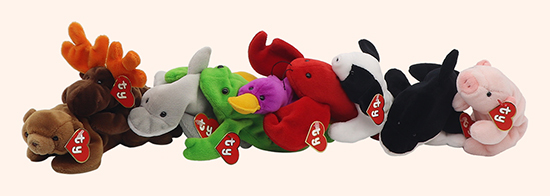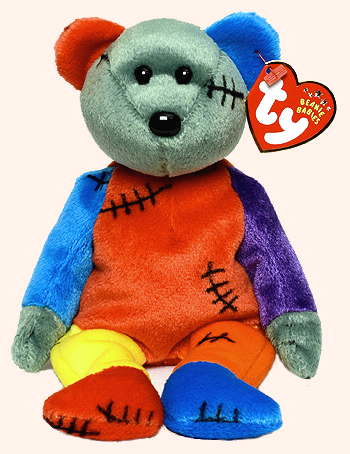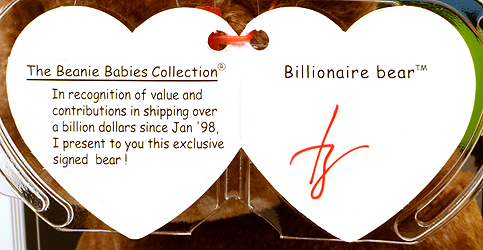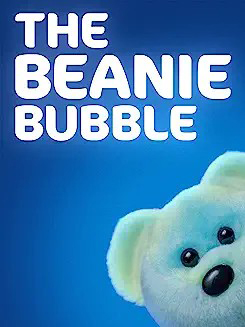The Rise and Fall of the Beanie Baby Gamblers
By Leon & Sondra Schlossberg
The "Original 9" Beanie Babies

INTRODUCTION
Since the year 1999, numerous newspapers, magazines, books, scholarly business papers and video specials have attempted to analyze and document the Rise and Fall of Ty Beanie Babies. Beanie Babies were introduced by H. Ty Warner in 1993 and started to show up on retailer shelves in the Chicago area in early 1994. They were not an "immediate" success.
Nationwide enthusiasm for these small plush animals did not begin to surge until mid 1996. The initial popularity of Beanie Babies was driven primarily by five factors or events:
- Beanie Babies were small and cute, but most importantly inexpensive. A collection of Beanie Babies didn't take up much space. Kids could
carry them around in a pocket, purse or book bag and they made great little gifts for special occasions. A cute Beanie Baby was a better
"I love you," "please forgive me," "thinking of you," or "I've got a crush on you" gift than a dozen fresh roses.
- A small group of entrepreneurs and speculators in and around Chicago, some acting independently and others in groups, saw the potential
of Beanie Babies as a collectible investment. These people started not only hoarding Beanie Babies but also published an avalanche of books,
magazines and Internet bulletin board postings that proclaimed the rarity and potential future value of Beanie Babies. The publishing avalanche
began in 1997 and lasted into 2001.
- Public media outlets like newspapers and national periodicals started to report on the rising interest in Beanie Babies in late 1996 after
Ty retired Humphrey, a Beanie Baby camel. That retirement sparked speculator beliefs there would be more retirements that would ensure the
perpetual rarity of most or all Beanie Babies. The media coverage of Beanie Babies was highly influenced by the first set of
entrepreneurs and speculators who were now considered "experts" on Beanie Babies by media representatives. The newspaper and other national
media outlets repeatedly chewed the cud of how rare and potentially valuable Beanie Babies might become. When speculative buying started to
drive up secondary market values of Beanie Babies, the media switched from reporting about "potential" values to report on how
valuable they had become.
- In April 1997, McDonalds launched a promotional Happy Meal giveaway of 10 Teenie Beanie Babies. The public response was so frenzied that
McDonalds ran out of the Teenies well before the promotion was scheduled to end. The unprecedented public reaction to this first McDonalds Ty
promotion stands as incontrovertible proof that Beanie Babies had seized the passions, dreams and pocketbooks of American consumers. It didn't
seem to matter that the Teenie Beanie Babies weren't even manufactured by Ty. What did seem to matter was the words "Beanie Babies" in the name
and the "Ty" tag attached to the stuffed animal.
- On 18 May 1997, the Chicago Cubs gave "Cubbie" Beanie Babies to the first 10,000 kids age 13 and under who attended that day's game.
The Cubbie giveaway started a Beanie Babies sports promotion trend in baseball, basketball, football and hockey that peaked in 1999, but still
continues with various major league teams. Well over a million Beanie Babies and other Ty plush products have been given out at major league
sports events. The practice even caught on in Japan.
This multifaceted deluge of Beanie Babies accompanied by the fawning media coverage caused a nationwide buying frenzy that lasted until the year 2000. Near the end of 1999 the bottom fell out of the Beanie Baby investment paradigm. New Internet services like bulletin boards, chat rooms and eBay exposed the myth of Beanie Baby "rarity." Collectors were finding it difficult to sell their collections as the secondary market became saturated. Ty was producing so many of each new Beanie Baby that it became highly unlikely any of them would ever become rare. The largest nail in the coffin of Beanie Baby investment was the Ty Inc. announcement in late 1999 that the entire Beanie Baby product line would be discontinued at the end of 2000. Consumers interpreted that announcement as a blatant marketing ploy to clear stock out of Ty's warehouses. That belief was reinforced when Ty made a U-Turn and announced the Ty product line would continue into 2001 after all.
Considering the fact that so many consumers (probably numbered in the millions) were gullible enough to believe a stuffed animal purchased for five dollars would increase in value to seven hundred or more dollars in ten or eleven years, it is surprising that those same dedicated consumers mutinied when they perceived they were being manipulated by Ty. By the end of 2001, it was obvious to most collectors with common sense that Beanie Baby values would never return to the levels seen during the height of the frenzy period.

Who says I'm unpopular?
The post-2000 theme of media articles trended into the "decline" of the Beanie Babies. Once again, the media unknowingly misrepresented the Beanie Baby story. It is true the values of all but the rarest Beanie Babies began a dramatic and continual decline in values, but that decline in values is not married to the Beanie Babies themselves.
The popularity of the Beanie Babies never declined. Their popularity shifted from gullible adults who speculated on their financial futures with small understuffed toy animals back to all of the kids who lost out on owning them because "they were worth too much to be played with." Adults no longer invested in Beanie Babies, but they continued to buy them for their kids. That was Ty's original vision for Beanie Babies in the first place. They were intended for kids.
ARCHEOLOGY APPLIED TO BEANIE BABY POPULARITY
To understand the popularity of Beanie Babies, you have to look at the Beanie Babies themselves. Popularity is defined by numbers sold, not values. The media somehow missed that simple fact.
We excavated the tycollector.com museum collection of Beanie Babies to see what they had to say about their own history. There seems no other place to look because Ty Inc. has never released information to the public about corporate earnings or information about how many of each Beanie Baby they produced, excepting the limited edition and numbered Beanie Babies.
The Beanie Babies we excavated didn't let us down. The best measure of Beanie Baby popularity turned out to be the Billionaire Beanie Babies. When you integrate the Billionaire Bears with the Ty corporate history timeline for new product introductions it becomes clear that even when the value bubble popped at the end of 1999, Beanie Baby popularity did not wane.
HISTORY ACCORDING TO THE BEANIE BABIES
Ty Inc. sales exceeded one billion dollars in 1998. Sales of the wildly popular "Princess" Beanie Baby probably accounted for a significant portion of that year's sales. To celebrate the achievement of one billion dollars in sales, Ty Inc. created and gave a unique and exclusive "Billionaire" Beanie Baby bear to every Ty employee. The Billionaire bear's swing tag was signed on the inside by Ty. The first Billionaire bear tells us it was given out:
“In recognition of value and
contributions in shipping over
a billion dollars since Jan '98,
I present to you this exclusive
signed bear !”

The swing tag for the first Billionaire Bear does not show how many were produced, but there was a non-verified estimate of approximately 1,400 at that time. At the end of 1999, Ty gave his employees the second Billionaire Beanie Baby for exceeding one billion dollars in sales. The swing tag for Billionaire II shows there were 475 produced. Ty then gave out a new Billionaire Beanie Baby for every year after that through the end of the year 2012. That is some convincing corroborative evidence that Ty Inc. had at least one billion dollars or more in sales for each of those years and that the Beanie Babies were selling as well as they did prior to 1998. There were a number of other product lines introduced during that period, but none overshadowed the Beanie Babies in popularity.
Billionaire Bears were not given to employees for 2013, 2014 or 2015. The drop of sales to below one billion for these years might be attributed to a number of factors, but our conclusion is that the decline to under a billion in sales was because of new product lines introduced during those years that seem to have flopped. Factory readjustments, development costs, and a non-existent collector base for the ultimately unsuccessful new product introductions would have resulted in decreased sales overall. These three years were also years during which Ty was significantly reducing the number of new Beanie Babies introduced every year while the Beanie Boos (introduced in 2009) increased in popularity worldwide.
Ty was in the process of successfully transitioning the “Beanie Babies” product line into the “Beanie Boos” product line. He was so effective with the transition that most consumers came to associate both of these product lines more with the “Ty” logo on the swing tag than the specific product line. Many consumers now see Beanie Boos in a store and automatically think "Beanie Babies."
New Billionaire Bears were given to employees in 2016, 2017, 2018 and 2019 indicating the return to over one billion dollars in sales for those years. Ty was shipping fewer and fewer Beanie Babies and more Beanie Boos. Consumers continued to buy both product lines. Ty had successfully morphed the Beanie Babies into Beanie Boos. For consumers, all that mattered was the "Ty" swing tag attached to their stuffed animal.
The Beanie Babies we dug up during our archeological journey provided additional data to show their continuing success after the value crash. The table below shows the number of new Beanie Babies introduced by Ty each year since they first appeared. Some collectors may question the validity of these numbers. That is because there is no consensus on how to determine the specific number of new Beanie Babies Ty produces every year. That dilemma is covered in another article for this series, "How Many Beanie Babies did Ty make?"
In 1996, Ty produced 27 new Beanie Babies. In 1997, Ty produced 46 new Beanie Babies. In 1998, Ty produced 28 new Beanie Babies and in 1999 Ty produced 54 new Beanie Babies. In 2000, the year Ty said he would discontinue the Beanie Babies, 75 new Beanie Babies hit the store shelves. That was the year values started their inexorable decline. Then in 2001, Ty produced 80 new Beanie Babies, followed by 115 new Beanies in 2002, 140 new Beanie Babies in 2003, 222 new Beanie Babies in 2004, 214 new Beanie Babies in 2005, 294 new Beanie Babies in 2006, 293 new Beanie Babies in 2007 and back down to 89 new Beanie Babies in 2008.
One must ask the question: "Why would Ty continue to increase the number of new Beanie Babies produced every year if their popularity had crashed. The only logical answer is that the popularity never crashed with the values.
2008, 2009 and 2010 marked an average new Beanie Baby introduction rate of 95 each year and 2011 was the year new annual introductions began a slow decline. It must be noted however, that Ty sales exceeded one billion dollars for all of these years from 1998 through 2010 and that level of sales continued into 2011 and 2012, as evidenced by the Billionaire Bears given to Ty employees in each of those years.
In 2013, a reasonably steady decline in new annual Beanie Baby introductions began as the popularity of the Beanie Boos increased along with the Boo spin-off product lines. New introductions of Beanie Babies dropped dramatically during the pandemic years of 2020 - 2022, due primarily to factory lockdowns in China, supply chain shortages worldwide and transportation issues that forced Ty Inc. to charter planes to move plush products from China to worldwide retailers.
In 2023, Ty introduced 22 new Beanie Babies. This included a series of 30th Anniversary Beanie Babies to commemorate the original introduction of the Beanie Babies product line.
The media reports of "The Rise and Fall of Beanie Babies" were incorrect. It was really "The Rise and Fall of the Beanie Baby Gamblers."
A documentary film about the Beanie Baby bubble (including appearances by Sondra & Leon Schlossberg) was released near the end of 2022 on selected pay-per-view media outlets. In early 2023, the documentary was released for free viewing by Amazon Prime members. This is one of the best documentaries about Beanie Babies we have seen. Check out this fun and informative documentary.
Even in this documentary, there appear to be inferences the Beanie Baby product line went the way of the dodo bird between the years years 1998 - 2001. Ignore the idea Beanie Babies suddenly went extinct. Most of the Beanie Baby gamblers were the ones who went extinct (or broke).


